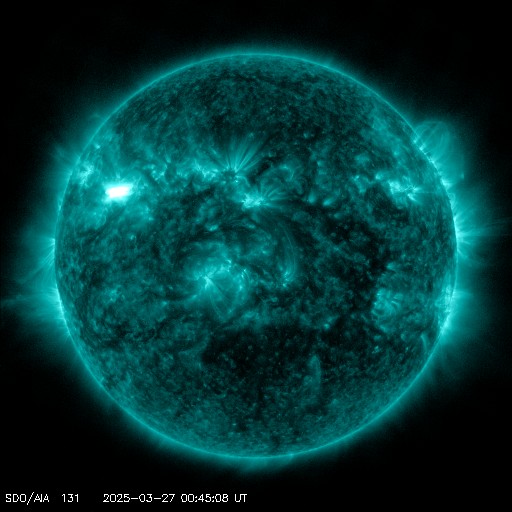Viewing archive of Monday, 18 April 2011
Solar activity report
Any mentioned solar flare in this report has a scaling factor applied by the Space Weather Prediction Center (SWPC). Because of the SWPC scaling factor, solar flares are reported as 42% smaller than for the science quality data. The scaling factor has been removed from our archived solar flare data to reflect the true physical units.
Report of Solar-Geophysical Activity 2011 Apr 18 2200 UTCPrepared by the NOAA © SWPC and processed by SpaceWeatherLive.com
Joint USAF/NOAA Report of Solar and Geophysical Activity
SDF Number 108 Issued at 2200Z on 18 Apr 2011IA. Analysis of Solar Active Regions and Activity from 17-2100Z to 18-2100Z
Solar activity has been at low levels for the past 24
hours. Region 1193 (N17E05) has been the most active, producing two
low-level C-class events. Region 1193 has remained rather stable but
continues to grow in sunspot number and magnetic complexity. At
18/0348Z, a C1 flare was observed off the west limb. There was a
non-earth directed CME associated with this event visible in LASCO
C2 imagery at 18/0412Z.
IB. Solar Activity Forecast
Solar activity is expected to be at
low levels with a chance for M-class events for the next three days
(19-21 April). Region 1190 (N13W68) is expected to rotate off the
visible disk in the next two days, while a new flux Region, visible
in STEREO Behind EIT imagery, is forecast to rotate onto the
southeast limb early on 19 April.
IIA. Geophysical Activity Summary 17-2100Z to 18-2100Z
The geomagnetic field has been at quiet to unsettled levels for the
past 24 hours. Quiet levels were observed till around 18/0634Z when
a 24 nT Sudden Impulse (SI) was observed by the Boulder
magnetometer. Following the arrival of this shock, mostly unsettled
levels were observed at mid latitudes with isolated active periods
at high latitudes. This increase in activity was due to the arrival
of a slow moving CME, observed lifting off the solar disk on 15
April.
IIB. Geophysical Activity Forecast
The geomagnetic field is
expected to be at quiet levels on day 1 (19 April). An increase to
unsettled geomagnetic levels with a chance for active periods is
expected on days 2 and 3 (20-21 April), due to the forecasted
arrival of a coronal hole high speed stream.
III. Event Probabilities 19 Apr to 21 Apr
| Class M | 20% | 20% | 20% |
| Class X | 01% | 01% | 01% |
| Proton | 01% | 01% | 01% |
| PCAF | Green | ||
IV. Penticton 10.7 cm Flux
Observed 18 Apr 111 Predicted 19 Apr-21 Apr 115/115/115 90 Day Mean 18 Apr 104
V. Geomagnetic A Indices
Observed Afr/Ap 17 Apr 002/005 Estimated Afr/Ap 18 Apr 007/008 Predicted Afr/Ap 19 Apr-21 Apr 005/005-010/010-010/010
VI. Geomagnetic Activity Probabilities 19 Apr to 21 Apr
| A. Middle Latitudes | |||
|---|---|---|---|
| Active | 10% | 35% | 25% |
| Minor storm | 01% | 10% | 05% |
| Major-severe storm | 01% | 01% | 01% |
| B. High Latitudes | |||
|---|---|---|---|
| Active | 10% | 40% | 30% |
| Minor storm | 01% | 15% | 10% |
| Major-severe storm | 01% | 00% | 01% |
All times in UTC
Current data suggests there is a slight possibility for aurora to appear at the following high latitude regions in the near future
NorilskLatest news
Latest forum messages
Incoming & Unnumbered Active Regions 1644AR4043 17Large Coronal Hole 25 152Photographing auroras 36Aurora photography hints for those of us with smartphones 43
More topicsSupport SpaceWeatherLive.com!
A lot of people come to SpaceWeatherLive to follow the Sun's activity or if there is aurora to be seen, but with more traffic comes higher server costs. Consider a donation if you enjoy SpaceWeatherLive so we can keep the website online!

Latest alerts
15:15 UTC - Geomagnetic activity
Minor G1 geomagnetic storm (Kp5) Threshold Reached: 14:59 UTC
09:15 UTC - Geomagnetic activity
Minor G1 geomagnetic storm (Kp5) Threshold Reached: 08:59 UTC
06:27 UTC - Hemispheric Power Index
The OVATION model predicts the Hemispheric Power Index to reach 54GW at 07:01 UTC
06:00 UTC - Geomagnetic activity
Minor G1 geomagnetic storm (Kp5) Threshold Reached: 05:51 UTC
00:57 UTC - Solar flare
Moderate M2.05 flare
Space weather facts
| Last X-flare | 2025/02/23 | X2.0 |
| Last M-flare | 2025/03/27 | M2.0 |
| Last geomagnetic storm | 2025/03/26 | Kp6+ (G2) |
| Spotless days | |
|---|---|
| Last spotless day | 2022/06/08 |
| Monthly mean Sunspot Number | |
|---|---|
| February 2025 | 154.6 +17.6 |
| March 2025 | 132.3 -22.3 |
| Last 30 days | 131.2 -21.8 |





